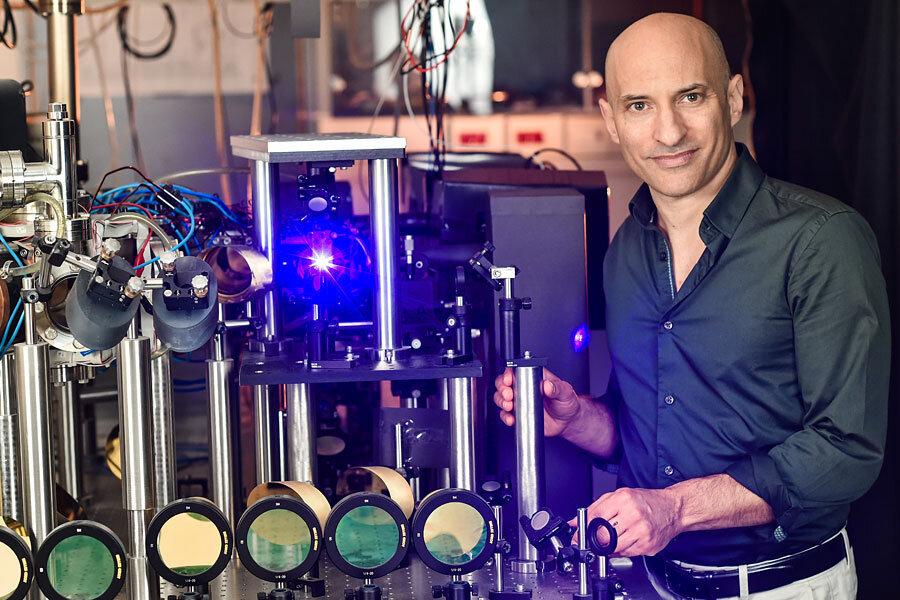Black holes may not be completely black. Stephen Hawking vindicated?
Loading...
Black holes aren't perfectly black, according to a famous prediction theoretical physicist Stephen Hawking made in 1974 suggesting that they emit radiation. And an experimental physicist from Technion-Israel Institute of Technology in Haifa may have just proved him right.
In his laboratory, Jeff Steinhauer built a simulation of a black hole using sound waves. And this tabletop model of the cosmic abyss indicates that radiation would be emitted, just as Dr. Hawking predicted decades ago, according to a paper published Monday in the journal Nature Physics.
Some scientists are still skeptical that this feat has been accomplished. But if Dr. Steinhauer has proven that quantum Hawking radiation is possible, as he reports, then theoretical physics may have just taken a leap forward in addressing some of the problems that dog it.
"My work confirms the existence of Hawking radiation," Steinhauer tells The Christian Science Monitor.
The concept of Hawking radiation arose from a premise of quantum theory, which says that pairs of light particles, photons, are constantly appearing and then immediately disappearing as they cancel each other out. As this supposedly occurs everywhere in space, Hawking pondered what would happen when these pairs spawn along the black hole's event horizon, the point-of-no return at which the black hole's escape velocity exceeds the speed of light.
He predicted that for the pair of photons that comes into existence on the event horizon, one photon would end up falling into the black hole while the other would escape out into space. And this separation would cause the black hole to radiate faintly.
If the black hole isn't gaining mass through other means, this so-called Hawking radiation would cause a black hole to shrink and eventually vanish.
Hawking radiation also creates a problem, called the information paradox.
Quantum mechanics dictates that information is never lost, but the information that has fallen into a black hole will disappear with it as it emits Hawking radiation. And Steinhauer's detection confirms that problem.
Steinhauer observed that a particle inside the analogue black hole is entangled with its counterpart outside, just as Hawking originally predicted for a real black hole. One idea to resolve the information paradox was that the information was preserved in the entanglement of particles outside of the black hole with other particles outside of the black hole.
But here's the catch: a particle can only be fully entangled with one other particle. Because Steinhauer noted that the entanglement occurs between partner particles across the event horizon of a black hole, the particles outside the black hole cannot be entangled with each other.
So, physicists will have to keep hunting for a solution to the information paradox.
"Physicists are interested in black holes because it's a testing ground for new laws of physics that physicists are trying to develop," Steinhauer says. So this detection "verifies some important elements of that discussion of the new laws of physics."
It's a unique challenge to observe a real black hole directly, so Steinhauer built an event horizon model that dealt with sound waves rather than light waves.
"The idea is that at the horizon, which is the boundary between the supersonic flow and the subsonic flow, that pairs of sound waves should be created spontaneously," he explains. And just like the photons in a real black hole, these phonons would be paired.
The phonons (a quantum of sound energy) inside the artificial black hole would be fighting against the supersonic flow, but the ones outside would be able to escape from the subsonic flow.
It's like trying to swim against a river, Steinhauer describes. If the flow of the river is faster than you can swim, you'll actually go backwards. And that's the case for the phonon that falls into the artificial black hole.
Theodore Jacobson, a theoretical physicist at the University of Maryland, is hesitant to celebrate Steinhauer's detection of quantum Hawking radiation. "This entanglement measure is very delicate and subtle," Dr. Jacobson tells the Monitor. "He needs to exclude certain other kinds of excitations being present in his system, and it's not clear to me that he verified that they're not present."
And, he adds, the detection of Hawking radiation on the quantum level hinges on detecting this entanglement.
"I'd like to see more detailed measurements of the system," Jacobson says, "but it looks plausible that he has really done it." And that would truly be groundbreaking.
Regardless, Jacobson calls Steinhauer's model a "remarkable accomplishment," as he has taken a theoretical idea and translated it into a real system in the laboratory.
Still, the acoustic model can't prove that Hawking radiation actually exists for real black holes, Stephen Hsu, a physicist at Michigan State University, says. Analogue systems like this one "are realizations of certain aspects of our mathematical description of black holes (i.e., in general relativity). We can not be entirely certain that this mathematical description is correct without direct experimental tests of real black holes," he writes in an email to the Monitor.
"Although most theoreticians are confident that Hawking radiation is real, the final arbiter is direct experimental observation," Dr. Hsu says.
Jacobson agrees, but, he says, "Being in a laboratory and seeing the analogue is the best we can do, at least for the moment and for the foreseeable future."
[Editor's note: This article has been updated to correct the relationship between the information paradox and the entanglement observed in the acoustic black hole.]








